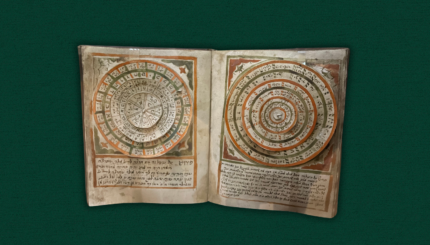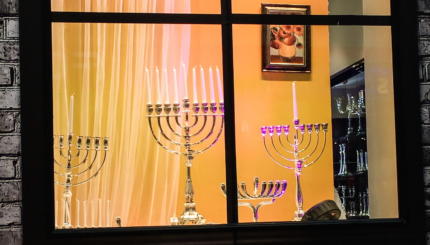The morning service is the usual holiday one, with its own Amidah and the Hallel Psalms of Praise. After Hallel, the hakafot processionals follow as on the night before. After the hakafot, all the Torah scrolls–except three–are returned to the Ark. Three scrolls are needed, one for the reading of the sidra [Torah portion] of Vezot HaBerakha [end of Deuteronomy],the second for the reading of the first chapter of the Book of Genesis, and the third for the concluding maftir portion [omitted in some liberal congregations].
Since the custom is for everyone to be honored with an aliyah on Simchat Torah, the section from Vezot HaBerakha is read over and over again. To facilitate this, large congregations will divide into smaller groups, each with its own Torah. Other congregations will call up more than one person at a time.
Usually the last aliyah is a special one, reserved for kol ha-ne’arim —“all the children.” Only this one time during the year, children who have not reached the age of bar or bat mitzvah are given a Torah honor. A large tallit [prayer shawl] is spread like a canopy over their heads as they say the blessings along with an adult who accompanies them.
The last part of the Torah reading from the first Torah scroll is the reading of the last verses of the Book of Deuteronomy (33:27-34:12) The person honored with this aliyah is called the chatan Torah–“groomof the Torah.” In synagogues that are egalitarian and offer equal participation to women, a woman may be given this honor, called the kallat HaTorah--“brideof the Torah.” This person is generally a distinguished member of the congregation, and is called up to the Torah with a special piyyut [liturgical poem]in praise of the Torah. The following is a suggested text for the calling up of the chatan Torah:
With your help, My Jewish Learning can provide endless opportunities for learning, connection and discovery.
“Requesting permission of God, mighty, awesome, and revered, and requesting permission of the Torah, our precious treasure which we celebrate, I lift up my voice in song with gratitude in praise of the One Who dwells in sublime light, Who has granted us life and sustained us with faith’s purity, Who has allowed us to reach this day of rejoicing in the Torah which grants honor and splendor, life and security, which brings joy to the heart and light to the eyes, and happiness to us when we in- corporate its values which we cherish. The Torah grants long days and strength to those who love and observe it, heeding its warnings absorbed in it with reverence and love without setting prior conditions. May it be the will of the Almighty to grant life, lovingkindness, and a crown of blessings in abundance to [insert name] who has been chosen for this reading of the Torah at its conclusion.”
After this aliyah, the beginning of Genesis (1:1-2:3) is, read from the second Torah scroll. The person honored with this aliyah is called the chatan Bereshit–“groomof Genesis” (or kallat Bereshit –“brideof Genesis”). Again, a special piyyutis recited. As the first chapter of Genesis is read, the congregation recites for each day of creation veyehi erev veyehi voker–“therewas evening and there was morning”–which is repeated by the Torah reader. It is customary in many places to spread a tallit like a canopy over the chatan Torah and chatan Bereshit.
The lifting of the second Torah scroll is done in a special fashion. The person crosses his or her hands so that the scroll, when lifted, is reversed (i.e., the Hebrew script is facing the congregation). [This is not done at all congregations.] This is done to symbolize turning the Torah back to its beginning–to Genesis.
The third scroll is the maftir scroll, from which the concluding Torah portion of Numbers 29:35-30:1 is read. This is followed by the chanting of the Simchat Torah Haftarah, from the first chapter of the Book of Joshua.
The Musaf (additional) service for Simchat Torah is the usual festival one, except that the joyous mood is maintained by the ingenuity of the reader. Latitude is given to merriment, and some synagogues allow tasteful “fooling around” in order to heighten the great joy of the day. Simchat Torah thus gives expression to the unbreakable chain — the Torah — that links past and future generations. In that chain lies the secret of the eternal validity of the Jewish people.
Excerpted from Every Person’s Guide to Sukkot, Shemini Atzeret, and Simchat Torah. Reprinted with permission of the publisher. Copyright 2000 Jason Aronson, Inc.
erev
Pronounced: EH-ruv, Origin: Hebrew, evening, eve, usually used to denote the first night of a Jewish holiday, such as Erev Yom Kippur (Jewish days begin at sundown).
Torah
Pronunced: TORE-uh, Origin: Hebrew, the Five Books of Moses.
aliyah
Pronounced: a-LEE-yuh for synagogue use, ah-lee-YAH for immigration to Israel, Origin: Hebrew, literally, "to go up." This can mean the honor of saying a blessing before and after the Torah reading during a worship service, or immigrating to Israel.
Haftarah
Pronounced: hahf-TOErah or hahf-TOE-ruh, Origin: Hebrew, a selection from one of the biblical books of the Prophets that is read in synagogue immediately following the Torah reading.
tallit
Pronounced: tah-LEET or TAH-liss, Origin: Hebrew, prayer shawl.


